|
The Leopard
Gecko
(Eublepharis
macularius)
By: Eric
Wilson - UltimateHerps™
Introduction:
Leopard Geckos have become very popular in the pet trade today. Many
breeders, amateurs and professionals alike, breed them and have produced many new
color morphs and combo-morphs such as Mack Snows/Mack Super Snows, Blazing Blizzards,
Raptors, Aptors, Enigmas, and many more. Since Leos are easy to care
for, breed, and are readily available in a large variety of beautiful
color morphs, it’s no wonder they’ve grown so popular in the pet trade
today! Leopard Geckos are a great beginner animal. They are cute, stay
relatively small, are low maintenance, and are generally inexpensive.
Plus, there’s loads of information about their care available on the
internet and in books. With proper care, Leos can live over twenty years
in captivity. Some have lived for more than thirty years.
Links:
VMS Herp-Leopard Gecko Trade Names
Care:
Native Range:
Most Leopard Geckos that are sold are Captive-Bred meaning that the
parents were bred in captivity and then the gecko hatched in captivity. Leopard Geckos are native to Pakistan, Afghanistan,
and India. In the wild they live near the desert and scrub-land in a
rocky habitat which provides a suitable shelter. They are nocturnal,
which means that they are active at night. They tend to hide underground
during the day to escape the heat. When dusk falls, they come out of
their shelters to hunt for insects.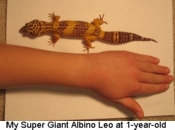
Size: When Leopard Geckos first hatch out of their egg, they
measure roughly four inches from nose-tip to tail-tip. As adults, they
grow to be eight to nine inches long on average.
Ron Tremper produced the Tremper Giant/Super Giant Leopard Geckos, a
Co-Dominant genetic morph. Within a years time, Giants
grow to be ten to eleven inches long, with females weighing 60g-90g and
males weighing 90g-110g. Within a years time, Super Giants
grow to be eleven to twleve inches long, with females weighing over 90g
and males obtaining weights of 110g-150g+! Now that's a big Leopard
Gecko!
Handling: A stressed baby Leopard Gecko can sometimes be a
challenge to handle. They will sometimes hiss and run
around their enclosure, but as they mature, they tame down nicely. A
newly bought Leopard Gecko shouldn’t be handled for a minimum of two to
three
days, and should be quarantined for four to six weeks. While in quarantine, the
Leo should be
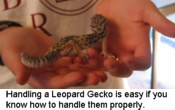 housed alone in a simple enclosure where you can
observe that it is eating and that it is healthy. You may also want to bring a fecal
sample to the vet to test for parasites (better safe than sorry).
Leopard Geckos rarely bite and are easy to handle as adults. To pick up
a Leopard Gecko, simply reach your hand into its enclosure and gently scoop the Leo up
so that it is
resting on your hand. As a precaution when holding a younger Leo for the
first time, you might consider handle your Leopard Gecko over its enclosure.
A Leopard Gecko that is frightened could leap
off your hand and make take a fatal fall if you are standing up and have
nothing below your hand to catch it. Once you have a feel for your young
Leopard Gecko's personality
and temperament, you can try holding him while standing up. Try not to
handle your Gecko too often, as it can cause unneeded stress. housed alone in a simple enclosure where you can
observe that it is eating and that it is healthy. You may also want to bring a fecal
sample to the vet to test for parasites (better safe than sorry).
Leopard Geckos rarely bite and are easy to handle as adults. To pick up
a Leopard Gecko, simply reach your hand into its enclosure and gently scoop the Leo up
so that it is
resting on your hand. As a precaution when holding a younger Leo for the
first time, you might consider handle your Leopard Gecko over its enclosure.
A Leopard Gecko that is frightened could leap
off your hand and make take a fatal fall if you are standing up and have
nothing below your hand to catch it. Once you have a feel for your young
Leopard Gecko's personality
and temperament, you can try holding him while standing up. Try not to
handle your Gecko too often, as it can cause unneeded stress.
Caging:
There is a wide variety of enclosures available that will match the
needs of a Leopard Gecko. A
ten-gallon tank works great for an adult Leopard Gecko. Another option
is a commercially available reptile cage, such as the Critter Keeper.
You may choose to house your Leo in a clear Rubbermaid container with
air holes in the side. Leopard Geckos don’t have any adhesive pads on
their toes, so a screen lid is not absolutely necessary in a tall cage, but it
will help keep crickets in and any "unwanted guests" out. Other
enclosures like the Critter
Keeper or a tub should have a lid.
Links:
VMS Herp-Leopard Gecko Care
Substrate:
Paper towels are ideal for baby and juvenile Leopard Geckos because they
won’t impacted the Leo, they are easy to clean, and they can hold some
humidity in them for hatchlings. You will need to replace the entire
paper towel at least every week. With adults, you can use news paper the
same way you do paper towels for baby and juvenile Leopard Geckos. Do
not use sand as a substrate for any Gecko at all, or they may ingest the
sand and become impacted. That goes for any type of loose substrate as well.
Leos constantly smell their environment with their tongues, which is why they
will often
lick you and their surroundings while walking). If you have them on sand
or any loose substrate, they may ingest enough of it to clog up their
digestive track. It can take anywhere from a couple days to a few years
before you see the visual effects of impaction. Their intestines are the
size of their smallest finger. Do you think a piece or group of sand
particles could fit through that? Calci-Sand and all of those small
grained sands will clump up when they get wet from the saliva and
digestive juices that your gecko has, so they too present a risk of
causing impaction even though they are deemed ‘safe’ on the
packages.
Food:
When you acquire a Leopard Gecko, ask the person that you are purchasing
it from what it is
feeding on. Mealworms, pinhead crickets, or small silkworms are ideal
for juvenile Leopard Geckos, while large crickets, silkworms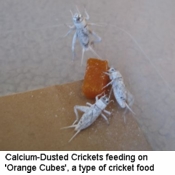 , and
certain species of roaches work great for adults. If you are feeding
mealworms or silkworms to your gecko, keep the worms in a shallow , and
certain species of roaches work great for adults. If you are feeding
mealworms or silkworms to your gecko, keep the worms in a shallow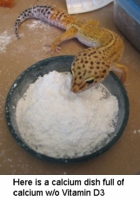 dish to prevent
them from escaping to other parts of the cage and hiding from your
Leopard Gecko. You can take the crickets hind legs off so they can’t
escape as easily if your gecko is having trouble catching them. Gut-load
crickets before offering them to your gecko. This means that you feed
the crickets a healthy diet for at least twenty four hours. There are
many commercial cricket diets available that work well for this. Another
option is to give the insects a piece of fruit or vegetable with either
some fish food or dog food, but make sure
that it isn’t dyed. Dust the insects that you are feeding your gecko
with reptile calcium powder that contains vitamin D3, such as Repti-Cal, at least
once every other week. If it is a breeding female, then you
need to dust the feeder insects daily. You can give a waxworm as an
occasional treat to your Leopard Geckos, but only around once a month maximum because wax-worms are very addictive and
are very high in fat.
Only use them to fatten up a Leopard Gecko that is extremely skinny
and that really needs fattening up. I suggest using silkworms instead of waxworms
because silkworms are extremely nutritious and Leopard Geckos love them.
dish to prevent
them from escaping to other parts of the cage and hiding from your
Leopard Gecko. You can take the crickets hind legs off so they can’t
escape as easily if your gecko is having trouble catching them. Gut-load
crickets before offering them to your gecko. This means that you feed
the crickets a healthy diet for at least twenty four hours. There are
many commercial cricket diets available that work well for this. Another
option is to give the insects a piece of fruit or vegetable with either
some fish food or dog food, but make sure
that it isn’t dyed. Dust the insects that you are feeding your gecko
with reptile calcium powder that contains vitamin D3, such as Repti-Cal, at least
once every other week. If it is a breeding female, then you
need to dust the feeder insects daily. You can give a waxworm as an
occasional treat to your Leopard Geckos, but only around once a month maximum because wax-worms are very addictive and
are very high in fat.
Only use them to fatten up a Leopard Gecko that is extremely skinny
and that really needs fattening up. I suggest using silkworms instead of waxworms
because silkworms are extremely nutritious and Leopard Geckos love them.
Water and Humidity:
Provide a shallow water dish with fresh, clean water for your Leopard
Gecko. The water bowl should be either as tall as, or shorter than your
Leopard Gecko. Clean the water bowl and put fresh water in it at least
once every week. Humidity should be kept low, otherwise
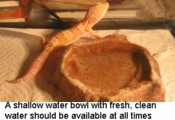 your
Leopard Gecko can suffer from respiratory problems. Some Leopard Geckos
will have trouble shedding their skin, especially their toes, if the humidity
in the cage is too low. If you see that your Gecko is shedding, or
having trouble shedding, simply put a moist hide in the tank if you
don’t already have one. This will increase the humidity in the cage
which will help your Leopard Gecko’s
shed skin to not remain stuck on the toes. Otherwise, the skin will
harden and block the blood from flowing into the toe which might result
in the loss of the toe. A moist hide can be constructed by flipping a
plastic container over and cutting a hole that is two to three times the
size of your Leopard Gecko. This will ensure that your Leopard Gecko
will not become stuck. Make sure that the edges of the hole in the
plastic container are smooth so that they do not injure your Leopard
Gecko. After you have done this, fill it up with either peat moss or
sphagnum moss. You can mix in some Bed-A-Beast or a similar product as
well. Make sure that the contents of the moist hide are damp, but not
wet. your
Leopard Gecko can suffer from respiratory problems. Some Leopard Geckos
will have trouble shedding their skin, especially their toes, if the humidity
in the cage is too low. If you see that your Gecko is shedding, or
having trouble shedding, simply put a moist hide in the tank if you
don’t already have one. This will increase the humidity in the cage
which will help your Leopard Gecko’s
shed skin to not remain stuck on the toes. Otherwise, the skin will
harden and block the blood from flowing into the toe which might result
in the loss of the toe. A moist hide can be constructed by flipping a
plastic container over and cutting a hole that is two to three times the
size of your Leopard Gecko. This will ensure that your Leopard Gecko
will not become stuck. Make sure that the edges of the hole in the
plastic container are smooth so that they do not injure your Leopard
Gecko. After you have done this, fill it up with either peat moss or
sphagnum moss. You can mix in some Bed-A-Beast or a similar product as
well. Make sure that the contents of the moist hide are damp, but not
wet.
Heating and Lighting:
There are a few different options when choosing how to heat your
Leopard Gecko's enclosure. If you are housing the gecko in an aquarium,
you can use a heating pad under one side of the enclosure or you can use a heat lamp
to heat one side of the cage. If you choose a heat pad, it should go
underneath the tank on one side. I would suggest using a separate
thermostat to control the heating pad since I've heard too many stories
of heating pads going haywire and burning reptiles. There are many
commercially available thermostats with all sorts of price ranges. Some
of the higher-end ones include Herpstat, Helix, Ranco, and Johnson. If you choose a heat lamp
instead, set it next to the tank and point it towards one side of the tank.
Either way, a quality digital thermometer with a probe or a temp gun is
a good idea. That way, you always know what temperature your cage is at.
It should be around 90 degrees Fahrenheit on the warm end during the day
and around 80 degrees Fahrenheit on the cooler side during the day. A
night temperature drop is not necessary, but if you choose to have one,
make sure that the temperatures are be between 78-84
degrees Fahrenheit during the night. Temperatures should never go above
95 degrees Fahrenheit and never go below 75 degrees Fahrenheit, at any
time.
Health Problems:
1. Your Leo may stop eating for many reasons. One, it may be getting
ready to shed or has just finished shedding (some Leos don’t eat during this
time). Another reason why it has stopped eating may be be cause
it is stressed out or is still adjusting to its environment. If this is
the case, don’t handle your Leo for a week or so. This can be caused by
a newly
rearranged cage, having just been purchased where it hasn’t yet adjusted
to its new environment, or it being bothered or handled too much. If
neither of those is the reason, check to make sure that the temperatures
in your cage are correct. Make sure that you are using a quality digital
thermometer or a temp gun to measure your temperatures.
Some thermometers, including the stick-on ones that I've seen for sale
at pet stores, have been know to be off by over twnety degrees! You can
also bring a fecal sample to the vet to test for parasites. Get further
instructions from your vet, but you may need to force feed the gecko or feed it ‘Jump Start’ (which stimulates the digestive
system and usually gets them eating again after a week or two). 2. Many
lizards (including Leos) have the ability to drop their tail in defense.
The tail will continue wiggling, distracting the predator, while the
lizard makes its escape. Over the next month or so, its tail will regrow.
Its new tail won’t look the same as the original, though, it will have a
more ‘bulbous’ appearance. If your Leo does drop its tail, do not worry.
Just dab a small amount of anti-biotics such as Neosporin or Polysporin
(make sure that it is the type without pain-killers, incase they lick
it) on the part of the tail that broke to keep it from becoming infected.
Also, try not to handle your Leo for a few days. If the tail does become
infected, please consult a Herp Vet for further instructions. 3. Calcium with
vitamin D3 is extremely important. Without it, Leos can develop MBD, Metabolic Bone Disease. If your Leo seems exhausted, in pain, or their
legs look really thin or are in really odd positions, then they might
have MBD. If you have any questions on MBD, consult a breeder or a Herp
Vet. cause
it is stressed out or is still adjusting to its environment. If this is
the case, don’t handle your Leo for a week or so. This can be caused by
a newly
rearranged cage, having just been purchased where it hasn’t yet adjusted
to its new environment, or it being bothered or handled too much. If
neither of those is the reason, check to make sure that the temperatures
in your cage are correct. Make sure that you are using a quality digital
thermometer or a temp gun to measure your temperatures.
Some thermometers, including the stick-on ones that I've seen for sale
at pet stores, have been know to be off by over twnety degrees! You can
also bring a fecal sample to the vet to test for parasites. Get further
instructions from your vet, but you may need to force feed the gecko or feed it ‘Jump Start’ (which stimulates the digestive
system and usually gets them eating again after a week or two). 2. Many
lizards (including Leos) have the ability to drop their tail in defense.
The tail will continue wiggling, distracting the predator, while the
lizard makes its escape. Over the next month or so, its tail will regrow.
Its new tail won’t look the same as the original, though, it will have a
more ‘bulbous’ appearance. If your Leo does drop its tail, do not worry.
Just dab a small amount of anti-biotics such as Neosporin or Polysporin
(make sure that it is the type without pain-killers, incase they lick
it) on the part of the tail that broke to keep it from becoming infected.
Also, try not to handle your Leo for a few days. If the tail does become
infected, please consult a Herp Vet for further instructions. 3. Calcium with
vitamin D3 is extremely important. Without it, Leos can develop MBD, Metabolic Bone Disease. If your Leo seems exhausted, in pain, or their
legs look really thin or are in really odd positions, then they might
have MBD. If you have any questions on MBD, consult a breeder or a Herp
Vet.
Breeding:
Sexing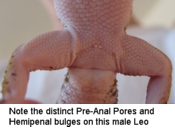 :
It is possible
to sex Leopard Geckos at a very young age once you know what to look
for. Most Leopard Gec :
It is possible
to sex Leopard Geckos at a very young age once you know what to look
for. Most Leopard Gec kos
are easy to sex at five to nine months old. By nine months, it should be
quite obvious whether it is a male or a female, although there are some exceptions.
Males become sexually mature
around nine months of age. Males will have two hemipenal bulges at
the base of their tail and a V-shaped set of pre-anal pores, usually
consisting of around thirteen pores. They will secrete a waxy substance
from these pores, often smearing it around their cage. This is their way
of marking/scenting their territory. Although females will also have these
pores, they aren’t as pronounced, and look like ‘pits’ when magnified instead of true pore. They are also harder to see with the
naked eye. Females will also lack the bulges at the base of the tail. kos
are easy to sex at five to nine months old. By nine months, it should be
quite obvious whether it is a male or a female, although there are some exceptions.
Males become sexually mature
around nine months of age. Males will have two hemipenal bulges at
the base of their tail and a V-shaped set of pre-anal pores, usually
consisting of around thirteen pores. They will secrete a waxy substance
from these pores, often smearing it around their cage. This is their way
of marking/scenting their territory. Although females will also have these
pores, they aren’t as pronounced, and look like ‘pits’ when magnified instead of true pore. They are also harder to see with the
naked eye. Females will also lack the bulges at the base of the tail.
Mating:
The breeding season for Leopard Geckos is usually January through September, but
sometimes it will continue into October. In order to have
fertile eggs, you obviously need a male Leopard Gecko and at least one
female Leopard Gecko. The female should be at least 45 grams, but 50g+ is
preferred. The male should be at least one year old in order to breed,
even though he will become sexually mature at about nine months of age.
You will need to put the male in the tank with the female for about one
week. In this time, the male will follow the female around and
eventually bite the female on the neck. He may start nibbling on her
back and gradually get up to her neck as well. This is normal, so don’t
separate them if you see this, unless he continues biting to the point
where he is going to
cause serious injury to the female. After he bite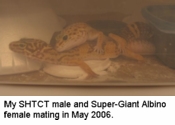 s the female Leopard
Gecko, he will mate with her. This will only take a few minutes. You can quietly observe, but don’t bother
them. You can take the male out of the enclosure when he is
finished mating to reduce the stress on the female. Females can retain
sperm, so it isn't mandatory to reintroduce a pair until the next breeding
season after a successful mating has been observed. I would suggest
pairing them together a few different times so that you can be sure to
receive fertile eggs from your female. Some breeders leave their males
in with a group of three or more females year round. When breeding
Leopard Geckos, it is essential to offer your females additional calcium
to aide in proper egg development. If you aren't already, offer a small dish or a
water bottle lid in the female’s enclosure filled with calcium powder,
but use the type that does not contain vitamin D3. This way, she can
receive
calcium whenever she needs it. And yes, they will sit there licking up
calcium powder when they really need it. Also, dust all of your feeder
insects with calcium every time you feed your female while she is
producing eggs. If you don’t think your female Leopard Gecko is gaining
enough weight, you can offer her some silkworms, which are extremely
nutritious, and maybe even a wax worm or two. Just be careful with the
waxworms,
as they are very high in fat and may become addicting to your Leopard
Gecko. s the female Leopard
Gecko, he will mate with her. This will only take a few minutes. You can quietly observe, but don’t bother
them. You can take the male out of the enclosure when he is
finished mating to reduce the stress on the female. Females can retain
sperm, so it isn't mandatory to reintroduce a pair until the next breeding
season after a successful mating has been observed. I would suggest
pairing them together a few different times so that you can be sure to
receive fertile eggs from your female. Some breeders leave their males
in with a group of three or more females year round. When breeding
Leopard Geckos, it is essential to offer your females additional calcium
to aide in proper egg development. If you aren't already, offer a small dish or a
water bottle lid in the female’s enclosure filled with calcium powder,
but use the type that does not contain vitamin D3. This way, she can
receive
calcium whenever she needs it. And yes, they will sit there licking up
calcium powder when they really need it. Also, dust all of your feeder
insects with calcium every time you feed your female while she is
producing eggs. If you don’t think your female Leopard Gecko is gaining
enough weight, you can offer her some silkworms, which are extremely
nutritious, and maybe even a wax worm or two. Just be careful with the
waxworms,
as they are very high in fat and may become addicting to your Leopard
Gecko.
Choosing/Making an Incubator:
An incubator can be made out of many different things. You can just buy an incubator like
the highly recommended Hova-Bator (without a fan), or you can make one
from scratch. If you choose to make one, you can use an aquarium with an
under tank heater underneath. Fill the aquarium half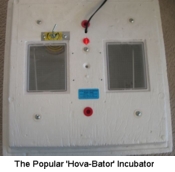 way
up with water.
Then, place two bricks in the water, but the top of the bricks need to
be at least an inch out of the water. Place a deli cup or the
container that you are using for the eggs on top of the bricks. The deli
cup or the container that you are using should contain either
vermiculite or perlite that is damp, but not wet. Make a dent
in the incubation medium to stick the eggs in. Either have a couple of tiny air
holes in the container or open the container once a week to allow fresh air
into the container. Also, have a digital thermometer with a probe in the
container so that you know what temperature it is so the eggs don’t
become too hot or too cold. Set the thermometer on the bricks next to the
egg container. Keep a lid on the tank to keep the
evaporating water in. This way, the humidity will rise. You do need to
have a couple of little holes in the lid to allow fresh air to come into
the aquarium, but not too large, otherwise you will let all
of the humidity out. If you are using a screen lid, be sure to place
towels over ¾ of the lid in order to keep the humidity in, otherwise the
majority of the moisture will go out through all the holes in the screen
lid. See, what will happen with this incubator is the under tank heater
will heat up the water, which will cause the water to evaporate, which
will also increase the humidity. The heated water will also heat the air
which will cause the
temperature to rise. You can also just take deli cups and set them on a
counter with a thermometer and a heat lamp, but then you will have to
make sure that the humidity stays at the correct level so that the eggs
do not dry out. You can also make
an incubator out of a cooler or an old refrigerator or freezer. So even
though it is possible to create your own incubator, I'd suggest just
purchasing a commercial incubator. There are some extremely affordable
incubators available and they will make the incubating process a whole
lot easier and less stressful! way
up with water.
Then, place two bricks in the water, but the top of the bricks need to
be at least an inch out of the water. Place a deli cup or the
container that you are using for the eggs on top of the bricks. The deli
cup or the container that you are using should contain either
vermiculite or perlite that is damp, but not wet. Make a dent
in the incubation medium to stick the eggs in. Either have a couple of tiny air
holes in the container or open the container once a week to allow fresh air
into the container. Also, have a digital thermometer with a probe in the
container so that you know what temperature it is so the eggs don’t
become too hot or too cold. Set the thermometer on the bricks next to the
egg container. Keep a lid on the tank to keep the
evaporating water in. This way, the humidity will rise. You do need to
have a couple of little holes in the lid to allow fresh air to come into
the aquarium, but not too large, otherwise you will let all
of the humidity out. If you are using a screen lid, be sure to place
towels over ¾ of the lid in order to keep the humidity in, otherwise the
majority of the moisture will go out through all the holes in the screen
lid. See, what will happen with this incubator is the under tank heater
will heat up the water, which will cause the water to evaporate, which
will also increase the humidity. The heated water will also heat the air
which will cause the
temperature to rise. You can also just take deli cups and set them on a
counter with a thermometer and a heat lamp, but then you will have to
make sure that the humidity stays at the correct level so that the eggs
do not dry out. You can also make
an incubator out of a cooler or an old refrigerator or freezer. So even
though it is possible to create your own incubator, I'd suggest just
purchasing a commercial incubator. There are some extremely affordable
incubators available and they will make the incubating process a whole
lot easier and less stressful!
Links:
Degei-Building an Incubator from a Cooler,
Clay Davenport-Making an Incubator out of an Old Fridge or Freezer
Egg Laying:
Egg Laying will normally take place three to four weeks after mating
occurs. A week or
two after mating, you should be able to tell whether or not your female is gravid by
looking at her stomach. Either place her in a clear container and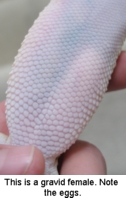 look through the bottom, or simply hold her up. If she is gravid, you
will be able to see them through her skin because the skin on her belly is partially
transparent. If you can see the eggs through her stomach, then she is
gravid. Be careful not to mistake internal organs for eggs. This is a
common mistake. A gravid female should be provided with an egg-laying box,
a suitable place for her to lay her eggs. An egg-laying box can be
constructed by flipping a plastic container over and cutting a hole that
is two to three times the size of your Leopard Gecko. This will ensure
that your Leopard Gecko will not become stuck. Make sure that the edges
of the hole in the plastic container are smooth so that they do not
injure your Leopard Gecko. After you have done this, fill it up with either peat moss
or sphagnum moss. You can mix in some Bed-A-Beast or a similar product
as well. Make sure that the contents of the moist hide are damp, but not
wet. People have successfully used moist paper
towels as well. I've even heard of people using vermiculite in their
egg-laying container.
look through the bottom, or simply hold her up. If she is gravid, you
will be able to see them through her skin because the skin on her belly is partially
transparent. If you can see the eggs through her stomach, then she is
gravid. Be careful not to mistake internal organs for eggs. This is a
common mistake. A gravid female should be provided with an egg-laying box,
a suitable place for her to lay her eggs. An egg-laying box can be
constructed by flipping a plastic container over and cutting a hole that
is two to three times the size of your Leopard Gecko. This will ensure
that your Leopard Gecko will not become stuck. Make sure that the edges
of the hole in the plastic container are smooth so that they do not
injure your Leopard Gecko. After you have done this, fill it up with either peat moss
or sphagnum moss. You can mix in some Bed-A-Beast or a similar product
as well. Make sure that the contents of the moist hide are damp, but not
wet. People have successfully used moist paper
towels as well. I've even heard of people using vermiculite in their
egg-laying container.
Over the next few days, your female Leopard Gecko will
spend lots of time in the egg-laying box. This is where she will most
likely lay her eggs, although some females get extremely active while
gravid, and prefer to lay their eggs in their water bowl or elsewhere
around the cage. Eggs, when laid, are usually about
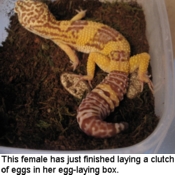 one inch in length and
roughly two-thirds to three-fourths of an inch wide. Set up your incubator when your
female Leopard Gecko is gravid or when you pair up your Leopard Geckos
for breeding because you need to have your incubator up and running at
the right temperature before you actually receive eggs. Females usually produce a clutch of eggs
every three to four weeks with an average of eight clutches (sixteen eggs).
Some females have successfully laid more than ten clutches (twenty eggs) in a
single breeding season. one inch in length and
roughly two-thirds to three-fourths of an inch wide. Set up your incubator when your
female Leopard Gecko is gravid or when you pair up your Leopard Geckos
for breeding because you need to have your incubator up and running at
the right temperature before you actually receive eggs. Females usually produce a clutch of eggs
every three to four weeks with an average of eight clutches (sixteen eggs).
Some females have successfully laid more than ten clutches (twenty eggs) in a
single breeding season.
If you see your female laying her eggs, do not
disturb her. Don’t take out the eggs until she has finished burring them
(if she's laying them in the egg-laying box), and if at all possible,
until she leaves the eggs. When you first find eggs in the egg-laying
box (or around the cage), take a sharpie and draw a line on
the top side of each egg running the length if the egg. This way, you can always tell which side
should be up incase the egg rolls over or turns during incubation. The embryo
forming inside can drown inside of the egg if the egg is turned from the
position in which the egg was laid. If you see that an egg has rolled a
bit, move it back so the line on the egg, that you drew with the sharpie, is
facing up. After you have drawn the line with the sharpie, take the eggs out and put them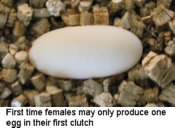 in the incubator, even if you think that they are infertile. You should
almost never throw away newly laid eggs because females can sometimes
retain sperm for a little over a year. Even if you don’t own a male, if
you acquired your female within the last year or so, she could have
mated and retained the sperm from before you received her. A fertile egg
will be white and will feel firm like a stale marshmallow, while an
infertile egg will feel like a hot water bottle, will have a yellowish
'tint' to it, and will look more translucent than a fertile egg. Females
will sometimes produce eggs without mating with a male, but these will
obviously be infertile and can be thrown away once you have confirmed
that they are indeed infertile. First time females may only produce one
egg for their first clutch, but this is normal and nothing is wrong with
your female.
in the incubator, even if you think that they are infertile. You should
almost never throw away newly laid eggs because females can sometimes
retain sperm for a little over a year. Even if you don’t own a male, if
you acquired your female within the last year or so, she could have
mated and retained the sperm from before you received her. A fertile egg
will be white and will feel firm like a stale marshmallow, while an
infertile egg will feel like a hot water bottle, will have a yellowish
'tint' to it, and will look more translucent than a fertile egg. Females
will sometimes produce eggs without mating with a male, but these will
obviously be infertile and can be thrown away once you have confirmed
that they are indeed infertile. First time females may only produce one
egg for their first clutch, but this is normal and nothing is wrong with
your female.
Links:
Leopard Gecko Eggs:
Laying Through Hatching,
VMS Herp-Breeding Leopard Geckos

Egg Binding:
If a female doesn’t weigh enough, or can’t support egg growth, she can
sometimes absorb her infertile eggs and receive all of the
nutrients from them. If the egg has been fertilized, then it is too late
for that. This is when egg binding occurs. Egg binding is a condition
when a female cannot lay or absorb her eggs, so they just sit there. If
you think your gravid female is egg bound, feel her underside where the
eggs are. If the eggs feel hard like rocks, then she is egg bound. Take
her to an herp vet and have the eggs surgically removed as soon
as possible. Egg binding is a serious condition and can kill your Leo if
not taken care of. If you think your Leo may become egg bound since she
won’t lay her eggs, soak her in luke warm water for thirty minutes and make
sure that the temperatures in her cage are correct. Also, make sure that she has a place
to lay her eggs. You can consult an herp vet if you are concerned about
egg binding.
Preparing the Incubation Container:
The container that you will be incubating the eggs in can be anything from
a deli-cu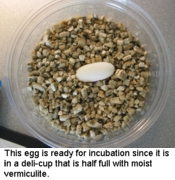 p, to a 24+ oz Rubbermaid container. The container that you
choose should be filled about halfway with moist vermiculite, perlite,
or a mix of both which usually consists of mostly vermiculite with just a
small amount of perlite mixed in. Many breeders carefully weigh out the water/medium ratio, usually something along the lines of 1g medium for
every 0.8g of water (by weight). Some people are able to tell “by feel”,
but I wouldn’t recommend attempting to judge it by feel unless you have
experience with it. Once you are ready to put eggs in, just take your thumb and make a thumb
imprint in the incubating medium for each egg to sit it. Place the egg
in the imprint and move the incubation medium against it until it
appears as if the egg is buried about
halfway in the medium. Be careful not to turn the egg at all, otherwise, you may drown
the growing embryo inside. Also, add two to three small holes in the
container for proper ventilation. You can also open up the container for
a few seconds once every week or so instead of having holes in the
incubation container. p, to a 24+ oz Rubbermaid container. The container that you
choose should be filled about halfway with moist vermiculite, perlite,
or a mix of both which usually consists of mostly vermiculite with just a
small amount of perlite mixed in. Many breeders carefully weigh out the water/medium ratio, usually something along the lines of 1g medium for
every 0.8g of water (by weight). Some people are able to tell “by feel”,
but I wouldn’t recommend attempting to judge it by feel unless you have
experience with it. Once you are ready to put eggs in, just take your thumb and make a thumb
imprint in the incubating medium for each egg to sit it. Place the egg
in the imprint and move the incubation medium against it until it
appears as if the egg is buried about
halfway in the medium. Be careful not to turn the egg at all, otherwise, you may drown
the growing embryo inside. Also, add two to three small holes in the
container for proper ventilation. You can also open up the container for
a few seconds once every week or so instead of having holes in the
incubation container.
Links:
Albey’s “Too Cool” Reptiles-How to Incubate
Incubation: Once you have your incubator up and running and you have eggs,
the
incubation process begins. The incubation process generally takes from
thirty five
days to seventy days or more. One of the cool features of the Leopard Gecko is
that you can almost decide which eggs you want to hatch out as males, and which
eggs you want to hatch out as females. This is called Temperature Dependant Sex Determination. For the
first twenty days or so of incubation, the
temperature plays a role in determining what the sex of the babies will
be. You will produce mostly males at temperatures of 88-90 degrees F,
you'll get mostly females at temperatures of 79-83 degrees F, and you'll
get a mix of males and females at 84-87 degrees F. If you incubate above
92 degrees F, it is said that you will most likely get “hot females”
meaning a female Leopard Gecko that was hatched at a very high
temperature. “Hot females” are normally very aggressive and are
incapable of producing offspring. It is recommended to house them alone
because of their aggression. The way I see it, is the warmer the
temperature of incubation, the more territorial and aggressive the
Leopard Gecko is since males are normally hatched at higher
temperatures and are territorial. This seems to hold true for "hot
females". I have no scientific data to back this up, but it would be
interesting to pay closer attention to this. Anyway, after the first 20
or so days, the amount of pigment is determined. The higher the temp (in
the 79-90 degrees F range) during the rest of incubation will give the
offspring less pigment. The babies will have more pigment at lower
temps. Also, the higher the temp, the quicker the babies will hatch.
females. This is called Temperature Dependant Sex Determination. For the
first twenty days or so of incubation, the
temperature plays a role in determining what the sex of the babies will
be. You will produce mostly males at temperatures of 88-90 degrees F,
you'll get mostly females at temperatures of 79-83 degrees F, and you'll
get a mix of males and females at 84-87 degrees F. If you incubate above
92 degrees F, it is said that you will most likely get “hot females”
meaning a female Leopard Gecko that was hatched at a very high
temperature. “Hot females” are normally very aggressive and are
incapable of producing offspring. It is recommended to house them alone
because of their aggression. The way I see it, is the warmer the
temperature of incubation, the more territorial and aggressive the
Leopard Gecko is since males are normally hatched at higher
temperatures and are territorial. This seems to hold true for "hot
females". I have no scientific data to back this up, but it would be
interesting to pay closer attention to this. Anyway, after the first 20
or so days, the amount of pigment is determined. The higher the temp (in
the 79-90 degrees F range) during the rest of incubation will give the
offspring less pigment. The babies will have more pigment at lower
temps. Also, the higher the temp, the quicker the babies will hatch.
Links:
Ron Tremper-Temperature Color Dependency
(www.leopardgecko.com)
Common Incubation Problems: During the incubation process, you may encounter some problems with the eggs. If
the e ggs become dented.
This is most likely from dehydration, so gently mist water around the egg and within a few hours, the egg
should rise ggs become dented.
This is most likely from dehydration, so gently mist water around the egg and within a few hours, the egg
should rise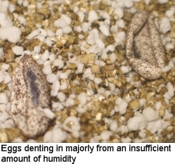 back up. Do not spray water directly on the egg, otherwise
mold may start growing on the egg, killing the developing embryo inside.
Mold on the egg can be caused either by having too high of humidity in the
container or by spraying water directly on the egg. Simply wipe off the
mold with a either a
normal towel, or apply an anti-bacterial athletes foot powder to a
tissue or a towel, and gently wipe the mold off of the egg. Leave the incubation
container open for fifteen minutes or more to allow some humidity to
escape and discourage continued mold growth. When the egg is getting
ready to hatch, it will collapse, so be careful not to throw away
collapsed eggs when they are nearing their
hatch date. I know people (even professional breeders) who have thrown
away eggs that they figured were either infertile or collapsed due to dehydration, and then have found baby geckos in their trash cans. back up. Do not spray water directly on the egg, otherwise
mold may start growing on the egg, killing the developing embryo inside.
Mold on the egg can be caused either by having too high of humidity in the
container or by spraying water directly on the egg. Simply wipe off the
mold with a either a
normal towel, or apply an anti-bacterial athletes foot powder to a
tissue or a towel, and gently wipe the mold off of the egg. Leave the incubation
container open for fifteen minutes or more to allow some humidity to
escape and discourage continued mold growth. When the egg is getting
ready to hatch, it will collapse, so be careful not to throw away
collapsed eggs when they are nearing their
hatch date. I know people (even professional breeders) who have thrown
away eggs that they figured were either infertile or collapsed due to dehydration, and then have found baby geckos in their trash cans.
Candling:
Candling is a process developed by farmers long ago to check if their chicken eggs were
fertile. They'd hold a candle near an egg in a dark room and they'd
look for veins in the egg so that they could see if there was an embryo
growing inside. You can use a very similar method with reptiles. After
the egg has been incubating for at least four to seven days, take the
egg into a dark room or turn the lights off in the room that you are in.
It you pick the egg up to move it into a dark room, be careful not to
turn the egg so that you do not drown the embryo
inside. Once you have it in a dark room, hold a small flashlight (a pen
light works well) right next to the egg. If the egg is fertile, veins
and/or the growing embryo will be present. A fertile egg will also have
a 'reddish/pinkish glow' when placed next to a small light. Do not spend
a lot of time candling and observing the egg because you do not want the
egg to be exposed to cooler temperatures for long periods of time.
Links:
Leopard Gecko Eggs:
Laying Through Hatching (Scroll down)
Hatching Process:
You can begin to anticipate the hatching process about a week before it actually
begins. Some of the signs that the hatching process is well on its way
to beginning is when the egg becomes noticeably larger than it was when it
was laid, sometimes up to twice its original size! The egg will start
to sweat and then it will collapse when it is hours away from hatching.
When the hatchling begins to hatch, it will make little slits in the egg
with its egg-tooth and then push its nose out. Then it will push its head out of
the egg, and then it might retreat
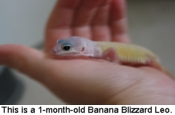 for a quick break.
During this break the baby gecko
will absorb the final remainder of its yolk sac. Then, it will go at it
again It might even clean itself as well. It will keep on working until
it gets its front legs, back legs, and its tail out of the egg. The
whole hatching process takes about two hours. After it hatches, it will
explore the container that it is in. You shouldn't bother it for at
least a few hours, although some breeders choose to leave them in their
hatching containers until they have completed their first shed, which
will take place roughly two to three days after the hatching process is
complete. If a hatchling hatches with its yolk sac still attached, it was
probably scared or stressed while hatching, so don’t bother it for at
least a day so that it will have some time to calm down. The new born Leopard Gecko won’t eat
until it completes its first shed, so you don’t need to offer food until
then. for a quick break.
During this break the baby gecko
will absorb the final remainder of its yolk sac. Then, it will go at it
again It might even clean itself as well. It will keep on working until
it gets its front legs, back legs, and its tail out of the egg. The
whole hatching process takes about two hours. After it hatches, it will
explore the container that it is in. You shouldn't bother it for at
least a few hours, although some breeders choose to leave them in their
hatching containers until they have completed their first shed, which
will take place roughly two to three days after the hatching process is
complete. If a hatchling hatches with its yolk sac still attached, it was
probably scared or stressed while hatching, so don’t bother it for at
least a day so that it will have some time to calm down. The new born Leopard Gecko won’t eat
until it completes its first shed, so you don’t need to offer food until
then.
Links:
Leopard Gecko Eggs:
Laying Through Hatching (Scroll down),
Albey’s “Too Cool” Reptiles-The Birth of a Leopard Gecko
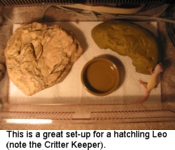
Raising Hatchlings:
Hatchling Leopard Geckos will start eating after they complete their
first shed. They should be kept on paper towels, and should be offered
three to five crickets, or
other prey items such as Silkworms, daily. If there are still multiple
feeder insects left in the enclosure, don’t add more unless there are
only a couple
left or the hatchling is looking for food. You can always remove uneaten
food items and add them back in at a later time. Change the paper towels
weekly if not every four to five days. Water should be available at all
times. Hatchlings should have a slightly higher humidity than adults. If
you can't provide an increased humidity, offer your juveniles a moist
hide to aide in shedding since juveniles shed constantly due to their
constant growth. They should be provided with at least one hide box. You can
begin to detect the signs of whether a juvenile Leopard Gecko is a male
or a female once it reaches the age of about three to five months, but
some males don't start developing until they reach six to nine months of
age.
Extra:
Do not let all of this information keep you from purchasing a Leopard Gecko. They are
extremely easy to keep. We have been keeping Leos since 2003. We have
learned from the past mistakes that were made when we first started to
keep Leopard Geckos and would like to help people to not make
the same mistakes that we did. Don’t think that you’re going to learn
everything overnight. Just continue to read about Leopard Geckos and
study them. We hope that this has increased your
knowledge of these amazing creatures.
Recommended Books:
The Herpetoculture of Leopard Geckos-By Ron Tremper, Philippe de Vosjoli, and Roger Klingenberg, D.V.M.-Twenty-Seven
Generations of Living Art
The Leopard Gecko Manual-By Philippe de Vosjoli with Roger Klingenberg, D.V.M., Ron Tremper, and
Brian Viets, Ph.D.
The Leopard Gecko-By Lyle Puente-part of the "Owner's Guide to a Happy Healthy Pet" series.
|


 housed alone in a simple enclosure where you can
observe that it is eating and that it is healthy. You may also want to bring a fecal
sample to the vet to test for parasites (better safe than sorry).
Leopard Geckos rarely bite and are easy to handle as adults. To pick up
a Leopard Gecko, simply reach your hand into its enclosure and gently scoop the Leo up
so that it is
resting on your hand. As a precaution when holding a younger Leo for the
first time, you might consider handle your Leopard Gecko over its enclosure.
A Leopard Gecko that is frightened could leap
off your hand and make take a fatal fall if you are standing up and have
nothing below your hand to catch it. Once you have a feel for your young
Leopard Gecko's personality
and temperament, you can try holding him while standing up. Try not to
handle your Gecko too often, as it can cause unneeded stress.
housed alone in a simple enclosure where you can
observe that it is eating and that it is healthy. You may also want to bring a fecal
sample to the vet to test for parasites (better safe than sorry).
Leopard Geckos rarely bite and are easy to handle as adults. To pick up
a Leopard Gecko, simply reach your hand into its enclosure and gently scoop the Leo up
so that it is
resting on your hand. As a precaution when holding a younger Leo for the
first time, you might consider handle your Leopard Gecko over its enclosure.
A Leopard Gecko that is frightened could leap
off your hand and make take a fatal fall if you are standing up and have
nothing below your hand to catch it. Once you have a feel for your young
Leopard Gecko's personality
and temperament, you can try holding him while standing up. Try not to
handle your Gecko too often, as it can cause unneeded stress.
 , and
certain species of roaches work great for adults. If you are feeding
mealworms or silkworms to your gecko, keep the worms in a shallow
, and
certain species of roaches work great for adults. If you are feeding
mealworms or silkworms to your gecko, keep the worms in a shallow dish to prevent
them from escaping to other parts of the cage and hiding from your
Leopard Gecko. You can take the crickets hind legs off so they can’t
escape as easily if your gecko is having trouble catching them. Gut-load
crickets before offering them to your gecko. This means that you feed
the crickets a healthy diet for at least twenty four hours. There are
many commercial cricket diets available that work well for this. Another
option is to give the insects a piece of fruit or vegetable with either
some fish food or dog food, but make sure
that it isn’t dyed. Dust the insects that you are feeding your gecko
with reptile calcium powder that contains vitamin D3, such as Repti-Cal, at least
once every other week. If it is a breeding female, then you
need to dust the feeder insects daily. You can give a waxworm as an
occasional treat to your Leopard Geckos, but only around once a month maximum because wax-worms are very addictive and
are very high in fat.
Only use them to fatten up a Leopard Gecko that is extremely skinny
and that really needs fattening up. I suggest using silkworms instead of waxworms
because silkworms are extremely nutritious and Leopard Geckos love them.
dish to prevent
them from escaping to other parts of the cage and hiding from your
Leopard Gecko. You can take the crickets hind legs off so they can’t
escape as easily if your gecko is having trouble catching them. Gut-load
crickets before offering them to your gecko. This means that you feed
the crickets a healthy diet for at least twenty four hours. There are
many commercial cricket diets available that work well for this. Another
option is to give the insects a piece of fruit or vegetable with either
some fish food or dog food, but make sure
that it isn’t dyed. Dust the insects that you are feeding your gecko
with reptile calcium powder that contains vitamin D3, such as Repti-Cal, at least
once every other week. If it is a breeding female, then you
need to dust the feeder insects daily. You can give a waxworm as an
occasional treat to your Leopard Geckos, but only around once a month maximum because wax-worms are very addictive and
are very high in fat.
Only use them to fatten up a Leopard Gecko that is extremely skinny
and that really needs fattening up. I suggest using silkworms instead of waxworms
because silkworms are extremely nutritious and Leopard Geckos love them. your
Leopard Gecko can suffer from respiratory problems. Some Leopard Geckos
will have trouble shedding their skin, especially their toes, if the humidity
in the cage is too low. If you see that your Gecko is shedding, or
having trouble shedding, simply put a moist hide in the tank if you
don’t already have one. This will increase the humidity in the cage
which will help your Leopard Gecko’s
shed skin to not remain stuck on the toes. Otherwise, the skin will
harden and block the blood from flowing into the toe which might result
in the loss of the toe. A moist hide can be constructed by flipping a
plastic container over and cutting a hole that is two to three times the
size of your Leopard Gecko. This will ensure that your Leopard Gecko
will not become stuck. Make sure that the edges of the hole in the
plastic container are smooth so that they do not injure your Leopard
Gecko. After you have done this, fill it up with either peat moss or
sphagnum moss. You can mix in some Bed-A-Beast or a similar product as
well. Make sure that the contents of the moist hide are damp, but not
wet.
your
Leopard Gecko can suffer from respiratory problems. Some Leopard Geckos
will have trouble shedding their skin, especially their toes, if the humidity
in the cage is too low. If you see that your Gecko is shedding, or
having trouble shedding, simply put a moist hide in the tank if you
don’t already have one. This will increase the humidity in the cage
which will help your Leopard Gecko’s
shed skin to not remain stuck on the toes. Otherwise, the skin will
harden and block the blood from flowing into the toe which might result
in the loss of the toe. A moist hide can be constructed by flipping a
plastic container over and cutting a hole that is two to three times the
size of your Leopard Gecko. This will ensure that your Leopard Gecko
will not become stuck. Make sure that the edges of the hole in the
plastic container are smooth so that they do not injure your Leopard
Gecko. After you have done this, fill it up with either peat moss or
sphagnum moss. You can mix in some Bed-A-Beast or a similar product as
well. Make sure that the contents of the moist hide are damp, but not
wet. cause
it is stressed out or is still adjusting to its environment. If this is
the case, don’t handle your Leo for a week or so. This can be caused by
a newly
rearranged cage, having just been purchased where it hasn’t yet adjusted
to its new environment, or it being bothered or handled too much. If
neither of those is the reason, check to make sure that the temperatures
in your cage are correct. Make sure that you are using a quality digital
thermometer or a temp gun to measure your temperatures.
Some thermometers, including the stick-on ones that I've seen for sale
at pet stores, have been know to be off by over twnety degrees! You can
also bring a fecal sample to the vet to test for parasites. Get further
instructions from your vet, but you may need to force feed the gecko or feed it ‘Jump Start’ (which stimulates the digestive
system and usually gets them eating again after a week or two). 2. Many
lizards (including Leos) have the ability to drop their tail in defense.
The tail will continue wiggling, distracting the predator, while the
lizard makes its escape. Over the next month or so, its tail will regrow.
Its new tail won’t look the same as the original, though, it will have a
more ‘bulbous’ appearance. If your Leo does drop its tail, do not worry.
Just dab a small amount of anti-biotics such as Neosporin or Polysporin
(make sure that it is the type without pain-killers, incase they lick
it) on the part of the tail that broke to keep it from becoming infected.
Also, try not to handle your Leo for a few days. If the tail does become
infected, please consult a Herp Vet for further instructions. 3. Calcium with
vitamin D3 is extremely important. Without it, Leos can develop MBD, Metabolic Bone Disease. If your Leo seems exhausted, in pain, or their
legs look really thin or are in really odd positions, then they might
have MBD. If you have any questions on MBD, consult a breeder or a Herp
Vet.
cause
it is stressed out or is still adjusting to its environment. If this is
the case, don’t handle your Leo for a week or so. This can be caused by
a newly
rearranged cage, having just been purchased where it hasn’t yet adjusted
to its new environment, or it being bothered or handled too much. If
neither of those is the reason, check to make sure that the temperatures
in your cage are correct. Make sure that you are using a quality digital
thermometer or a temp gun to measure your temperatures.
Some thermometers, including the stick-on ones that I've seen for sale
at pet stores, have been know to be off by over twnety degrees! You can
also bring a fecal sample to the vet to test for parasites. Get further
instructions from your vet, but you may need to force feed the gecko or feed it ‘Jump Start’ (which stimulates the digestive
system and usually gets them eating again after a week or two). 2. Many
lizards (including Leos) have the ability to drop their tail in defense.
The tail will continue wiggling, distracting the predator, while the
lizard makes its escape. Over the next month or so, its tail will regrow.
Its new tail won’t look the same as the original, though, it will have a
more ‘bulbous’ appearance. If your Leo does drop its tail, do not worry.
Just dab a small amount of anti-biotics such as Neosporin or Polysporin
(make sure that it is the type without pain-killers, incase they lick
it) on the part of the tail that broke to keep it from becoming infected.
Also, try not to handle your Leo for a few days. If the tail does become
infected, please consult a Herp Vet for further instructions. 3. Calcium with
vitamin D3 is extremely important. Without it, Leos can develop MBD, Metabolic Bone Disease. If your Leo seems exhausted, in pain, or their
legs look really thin or are in really odd positions, then they might
have MBD. If you have any questions on MBD, consult a breeder or a Herp
Vet. :
It is possible
to sex Leopard Geckos at a very young age once you know what to look
for. Most Leopard Gec
:
It is possible
to sex Leopard Geckos at a very young age once you know what to look
for. Most Leopard Gec s the female Leopard
Gecko, he will mate with her. This will only take a few minutes. You can quietly observe, but don’t bother
them. You can take the male out of the enclosure when he is
finished mating to reduce the stress on the female. Females can retain
sperm, so it isn't mandatory to reintroduce a pair until the next breeding
season after a successful mating has been observed. I would suggest
pairing them together a few different times so that you can be sure to
receive fertile eggs from your female. Some breeders leave their males
in with a group of three or more females year round. When breeding
Leopard Geckos, it is essential to offer your females additional calcium
to aide in proper egg development. If you aren't already, offer a small dish or a
water bottle lid in the female’s enclosure filled with calcium powder,
but use the type that does not contain vitamin D3. This way, she can
receive
calcium whenever she needs it. And yes, they will sit there licking up
calcium powder when they really need it. Also, dust all of your feeder
insects with calcium every time you feed your female while she is
producing eggs. If you don’t think your female Leopard Gecko is gaining
enough weight, you can offer her some silkworms, which are extremely
nutritious, and maybe even a wax worm or two. Just be careful with the
waxworms,
as they are very high in fat and may become addicting to your Leopard
Gecko.
s the female Leopard
Gecko, he will mate with her. This will only take a few minutes. You can quietly observe, but don’t bother
them. You can take the male out of the enclosure when he is
finished mating to reduce the stress on the female. Females can retain
sperm, so it isn't mandatory to reintroduce a pair until the next breeding
season after a successful mating has been observed. I would suggest
pairing them together a few different times so that you can be sure to
receive fertile eggs from your female. Some breeders leave their males
in with a group of three or more females year round. When breeding
Leopard Geckos, it is essential to offer your females additional calcium
to aide in proper egg development. If you aren't already, offer a small dish or a
water bottle lid in the female’s enclosure filled with calcium powder,
but use the type that does not contain vitamin D3. This way, she can
receive
calcium whenever she needs it. And yes, they will sit there licking up
calcium powder when they really need it. Also, dust all of your feeder
insects with calcium every time you feed your female while she is
producing eggs. If you don’t think your female Leopard Gecko is gaining
enough weight, you can offer her some silkworms, which are extremely
nutritious, and maybe even a wax worm or two. Just be careful with the
waxworms,
as they are very high in fat and may become addicting to your Leopard
Gecko. way
up with water.
Then, place two bricks in the water, but the top of the bricks need to
be at least an inch out of the water. Place a deli cup or the
container that you are using for the eggs on top of the bricks. The deli
cup or the container that you are using should contain either
vermiculite or perlite that is damp, but not wet. Make a dent
in the incubation medium to stick the eggs in. Either have a couple of tiny air
holes in the container or open the container once a week to allow fresh air
into the container. Also, have a digital thermometer with a probe in the
container so that you know what temperature it is so the eggs don’t
become too hot or too cold. Set the thermometer on the bricks next to the
egg container. Keep a lid on the tank to keep the
evaporating water in. This way, the humidity will rise. You do need to
have a couple of little holes in the lid to allow fresh air to come into
the aquarium, but not too large, otherwise you will let all
of the humidity out. If you are using a screen lid, be sure to place
towels over ¾ of the lid in order to keep the humidity in, otherwise the
majority of the moisture will go out through all the holes in the screen
lid. See, what will happen with this incubator is the under tank heater
will heat up the water, which will cause the water to evaporate, which
will also increase the humidity. The heated water will also heat the air
which will cause the
temperature to rise. You can also just take deli cups and set them on a
counter with a thermometer and a heat lamp, but then you will have to
make sure that the humidity stays at the correct level so that the eggs
do not dry out. You can also make
an incubator out of a cooler or an old refrigerator or freezer. So even
though it is possible to create your own incubator, I'd suggest just
purchasing a commercial incubator. There are some extremely affordable
incubators available and they will make the incubating process a whole
lot easier and less stressful!
way
up with water.
Then, place two bricks in the water, but the top of the bricks need to
be at least an inch out of the water. Place a deli cup or the
container that you are using for the eggs on top of the bricks. The deli
cup or the container that you are using should contain either
vermiculite or perlite that is damp, but not wet. Make a dent
in the incubation medium to stick the eggs in. Either have a couple of tiny air
holes in the container or open the container once a week to allow fresh air
into the container. Also, have a digital thermometer with a probe in the
container so that you know what temperature it is so the eggs don’t
become too hot or too cold. Set the thermometer on the bricks next to the
egg container. Keep a lid on the tank to keep the
evaporating water in. This way, the humidity will rise. You do need to
have a couple of little holes in the lid to allow fresh air to come into
the aquarium, but not too large, otherwise you will let all
of the humidity out. If you are using a screen lid, be sure to place
towels over ¾ of the lid in order to keep the humidity in, otherwise the
majority of the moisture will go out through all the holes in the screen
lid. See, what will happen with this incubator is the under tank heater
will heat up the water, which will cause the water to evaporate, which
will also increase the humidity. The heated water will also heat the air
which will cause the
temperature to rise. You can also just take deli cups and set them on a
counter with a thermometer and a heat lamp, but then you will have to
make sure that the humidity stays at the correct level so that the eggs
do not dry out. You can also make
an incubator out of a cooler or an old refrigerator or freezer. So even
though it is possible to create your own incubator, I'd suggest just
purchasing a commercial incubator. There are some extremely affordable
incubators available and they will make the incubating process a whole
lot easier and less stressful! look through the bottom, or simply hold her up. If she is gravid, you
will be able to see them through her skin because the skin on her belly is partially
transparent. If you can see the eggs through her stomach, then she is
gravid. Be careful not to mistake internal organs for eggs. This is a
common mistake. A gravid female should be provided with an egg-laying box,
a suitable place for her to lay her eggs. An egg-laying box can be
constructed by flipping a plastic container over and cutting a hole that
is two to three times the size of your Leopard Gecko. This will ensure
that your Leopard Gecko will not become stuck. Make sure that the edges
of the hole in the plastic container are smooth so that they do not
injure your Leopard Gecko. After you have done this, fill it up with either peat moss
or sphagnum moss. You can mix in some Bed-A-Beast or a similar product
as well. Make sure that the contents of the moist hide are damp, but not
wet. People have successfully used moist paper
towels as well. I've even heard of people using vermiculite in their
egg-laying container.
look through the bottom, or simply hold her up. If she is gravid, you
will be able to see them through her skin because the skin on her belly is partially
transparent. If you can see the eggs through her stomach, then she is
gravid. Be careful not to mistake internal organs for eggs. This is a
common mistake. A gravid female should be provided with an egg-laying box,
a suitable place for her to lay her eggs. An egg-laying box can be
constructed by flipping a plastic container over and cutting a hole that
is two to three times the size of your Leopard Gecko. This will ensure
that your Leopard Gecko will not become stuck. Make sure that the edges
of the hole in the plastic container are smooth so that they do not
injure your Leopard Gecko. After you have done this, fill it up with either peat moss
or sphagnum moss. You can mix in some Bed-A-Beast or a similar product
as well. Make sure that the contents of the moist hide are damp, but not
wet. People have successfully used moist paper
towels as well. I've even heard of people using vermiculite in their
egg-laying container. one inch in length and
roughly two-thirds to three-fourths of an inch wide. Set up your incubator when your
female Leopard Gecko is gravid or when you pair up your Leopard Geckos
for breeding because you need to have your incubator up and running at
the right temperature before you actually receive eggs. Females usually produce a clutch of eggs
every three to four weeks with an average of eight clutches (sixteen eggs).
Some females have successfully laid more than ten clutches (twenty eggs) in a
single breeding season.
one inch in length and
roughly two-thirds to three-fourths of an inch wide. Set up your incubator when your
female Leopard Gecko is gravid or when you pair up your Leopard Geckos
for breeding because you need to have your incubator up and running at
the right temperature before you actually receive eggs. Females usually produce a clutch of eggs
every three to four weeks with an average of eight clutches (sixteen eggs).
Some females have successfully laid more than ten clutches (twenty eggs) in a
single breeding season. in the incubator, even if you think that they are infertile. You should
almost never throw away newly laid eggs because females can sometimes
retain sperm for a little over a year. Even if you don’t own a male, if
you acquired your female within the last year or so, she could have
mated and retained the sperm from before you received her. A fertile egg
will be white and will feel firm like a stale marshmallow, while an
infertile egg will feel like a hot water bottle, will have a yellowish
'tint' to it, and will look more translucent than a fertile egg. Females
will sometimes produce eggs without mating with a male, but these will
obviously be infertile and can be thrown away once you have confirmed
that they are indeed infertile. First time females may only produce one
egg for their first clutch, but this is normal and nothing is wrong with
your female.
in the incubator, even if you think that they are infertile. You should
almost never throw away newly laid eggs because females can sometimes
retain sperm for a little over a year. Even if you don’t own a male, if
you acquired your female within the last year or so, she could have
mated and retained the sperm from before you received her. A fertile egg
will be white and will feel firm like a stale marshmallow, while an
infertile egg will feel like a hot water bottle, will have a yellowish
'tint' to it, and will look more translucent than a fertile egg. Females
will sometimes produce eggs without mating with a male, but these will
obviously be infertile and can be thrown away once you have confirmed
that they are indeed infertile. First time females may only produce one
egg for their first clutch, but this is normal and nothing is wrong with
your female.
 p, to a 24+ oz Rubbermaid container. The container that you
choose should be filled about halfway with moist vermiculite, perlite,
or a mix of both which usually consists of mostly vermiculite with just a
small amount of perlite mixed in. Many breeders carefully weigh out the water/medium ratio, usually something along the lines of 1g medium for
every 0.8g of water (by weight). Some people are able to tell “by feel”,
but I wouldn’t recommend attempting to judge it by feel unless you have
experience with it. Once you are ready to put eggs in, just take your thumb and make a thumb
imprint in the incubating medium for each egg to sit it. Place the egg
in the imprint and move the incubation medium against it until it
appears as if the egg is buried about
halfway in the medium. Be careful not to turn the egg at all, otherwise, you may drown
the growing embryo inside. Also, add two to three small holes in the
container for proper ventilation. You can also open up the container for
a few seconds once every week or so instead of having holes in the
incubation container.
p, to a 24+ oz Rubbermaid container. The container that you
choose should be filled about halfway with moist vermiculite, perlite,
or a mix of both which usually consists of mostly vermiculite with just a
small amount of perlite mixed in. Many breeders carefully weigh out the water/medium ratio, usually something along the lines of 1g medium for
every 0.8g of water (by weight). Some people are able to tell “by feel”,
but I wouldn’t recommend attempting to judge it by feel unless you have
experience with it. Once you are ready to put eggs in, just take your thumb and make a thumb
imprint in the incubating medium for each egg to sit it. Place the egg
in the imprint and move the incubation medium against it until it
appears as if the egg is buried about
halfway in the medium. Be careful not to turn the egg at all, otherwise, you may drown
the growing embryo inside. Also, add two to three small holes in the
container for proper ventilation. You can also open up the container for
a few seconds once every week or so instead of having holes in the
incubation container. females. This is called Temperature Dependant Sex Determination. For the
first twenty days or so of incubation, the
temperature plays a role in determining what the sex of the babies will
be. You will produce mostly males at temperatures of 88-90 degrees F,
you'll get mostly females at temperatures of 79-83 degrees F, and you'll
get a mix of males and females at 84-87 degrees F. If you incubate above
92 degrees F, it is said that you will most likely get “hot females”
meaning a female Leopard Gecko that was hatched at a very high
temperature. “Hot females” are normally very aggressive and are
incapable of producing offspring. It is recommended to house them alone
because of their aggression. The way I see it, is the warmer the
temperature of incubation, the more territorial and aggressive the
Leopard Gecko is since males are normally hatched at higher
temperatures and are territorial. This seems to hold true for "hot
females". I have no scientific data to back this up, but it would be
interesting to pay closer attention to this. Anyway, after the first 20
or so days, the amount of pigment is determined. The higher the temp (in
the 79-90 degrees F range) during the rest of incubation will give the
offspring less pigment. The babies will have more pigment at lower
temps. Also, the higher the temp, the quicker the babies will hatch.
females. This is called Temperature Dependant Sex Determination. For the
first twenty days or so of incubation, the
temperature plays a role in determining what the sex of the babies will
be. You will produce mostly males at temperatures of 88-90 degrees F,
you'll get mostly females at temperatures of 79-83 degrees F, and you'll
get a mix of males and females at 84-87 degrees F. If you incubate above
92 degrees F, it is said that you will most likely get “hot females”
meaning a female Leopard Gecko that was hatched at a very high
temperature. “Hot females” are normally very aggressive and are
incapable of producing offspring. It is recommended to house them alone
because of their aggression. The way I see it, is the warmer the
temperature of incubation, the more territorial and aggressive the
Leopard Gecko is since males are normally hatched at higher
temperatures and are territorial. This seems to hold true for "hot
females". I have no scientific data to back this up, but it would be
interesting to pay closer attention to this. Anyway, after the first 20
or so days, the amount of pigment is determined. The higher the temp (in
the 79-90 degrees F range) during the rest of incubation will give the
offspring less pigment. The babies will have more pigment at lower
temps. Also, the higher the temp, the quicker the babies will hatch. ggs become dented.
This is most likely from dehydration, so gently mist water around the egg and within a few hours, the egg
should rise
ggs become dented.
This is most likely from dehydration, so gently mist water around the egg and within a few hours, the egg
should rise back up. Do not spray water directly on the egg, otherwise
mold may start growing on the egg, killing the developing embryo inside.
Mold on the egg can be caused either by having too high of humidity in the
container or by spraying water directly on the egg. Simply wipe off the
mold with a either a
normal towel, or apply an anti-bacterial athletes foot powder to a
tissue or a towel, and gently wipe the mold off of the egg. Leave the incubation
container open for fifteen minutes or more to allow some humidity to
escape and discourage continued mold growth. When the egg is getting
ready to hatch, it will collapse, so be careful not to throw away
collapsed eggs when they are nearing their
hatch date. I know people (even professional breeders) who have thrown
away eggs that they figured were either infertile or collapsed due to dehydration, and then have found baby geckos in their trash cans.
back up. Do not spray water directly on the egg, otherwise
mold may start growing on the egg, killing the developing embryo inside.
Mold on the egg can be caused either by having too high of humidity in the
container or by spraying water directly on the egg. Simply wipe off the
mold with a either a
normal towel, or apply an anti-bacterial athletes foot powder to a
tissue or a towel, and gently wipe the mold off of the egg. Leave the incubation
container open for fifteen minutes or more to allow some humidity to
escape and discourage continued mold growth. When the egg is getting
ready to hatch, it will collapse, so be careful not to throw away
collapsed eggs when they are nearing their
hatch date. I know people (even professional breeders) who have thrown
away eggs that they figured were either infertile or collapsed due to dehydration, and then have found baby geckos in their trash cans. for a quick break.
During this break the baby gecko
will absorb the final remainder of its yolk sac. Then, it will go at it
again It might even clean itself as well. It will keep on working until
it gets its front legs, back legs, and its tail out of the egg. The
whole hatching process takes about two hours. After it hatches, it will
explore the container that it is in. You shouldn't bother it for at
least a few hours, although some breeders choose to leave them in their
hatching containers until they have completed their first shed, which
will take place roughly two to three days after the hatching process is
complete. If a hatchling hatches with its yolk sac still attached, it was
probably scared or stressed while hatching, so don’t bother it for at
least a day so that it will have some time to calm down. The new born Leopard Gecko won’t eat
until it completes its first shed, so you don’t need to offer food until
then.
for a quick break.
During this break the baby gecko
will absorb the final remainder of its yolk sac. Then, it will go at it
again It might even clean itself as well. It will keep on working until
it gets its front legs, back legs, and its tail out of the egg. The
whole hatching process takes about two hours. After it hatches, it will
explore the container that it is in. You shouldn't bother it for at
least a few hours, although some breeders choose to leave them in their
hatching containers until they have completed their first shed, which
will take place roughly two to three days after the hatching process is
complete. If a hatchling hatches with its yolk sac still attached, it was
probably scared or stressed while hatching, so don’t bother it for at
least a day so that it will have some time to calm down. The new born Leopard Gecko won’t eat
until it completes its first shed, so you don’t need to offer food until
then.